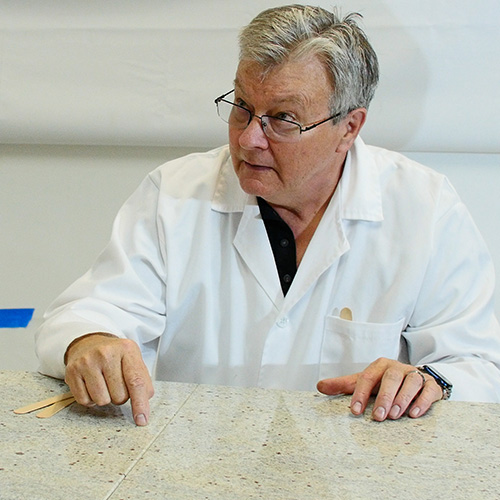High-Volume Peroxide: The Ultimate Stone Stain Remover
High-Volume Peroxide: The Ultimate Stone Stain Remover
Frederick M Hueston | StoneForensics.com
When it comes to maintaining the pristine appearance of stone surfaces, whether it’s the marble countertop in your kitchen, the granite vanity in your bathroom, or the limestone tiles in your entryway, stains can be a real headache. These stubborn marks, from spills to water rings and even mildew, can mar the beauty of natural stone. But there’s a secret weapon that can help restore your stone surfaces to their original splendor: peroxide. However, not all peroxides are created equal, and there’s a bit more to using this common chemical than you might think.
First, let’s talk about what peroxide is.
At its core, hydrogen peroxide is a simple molecule (H₂O₂) – basically water with an extra oxygen atom. This extra oxygen makes it a powerful oxidizing agent, which is why it’s so effective at bleaching and disinfecting. When it comes to cleaning, this means it can break down the organic compounds that cause stains, effectively “lifting” them from surfaces without the abrasive action that might damage delicate stone.
However, before you rush to your bathroom cabinet for that brown bottle of hydrogen peroxide you use for cuts and scrapes, there’s an important caveat. The peroxide typically found in drug stores is quite weak, usually around a 3% concentration. While it’s great for minor medical needs and even some light cleaning tasks, it’s not going to pack the punch you need for tough stains on stone surfaces. This low concentration might not be enough to break down stubborn stains effectively, and you could end up scrubbing away with little to no results.
For those tougher jobs, you’ll need to look for stronger peroxides.
Interestingly, one of the best places to find higher concentrations of hydrogen peroxide is not a home improvement store, but a beauty supply store. Here, peroxide is sold as a hair developer, used to lift color from hair before dyeing. Hair developers come in various strengths, indicated by “volume.” For stone cleaning, you’ll find developers in 10, 20, and even 40 volume. These numbers refer to the percentage of peroxide in the solution, with 10 volume being roughly 3% hydrogen peroxide (similar to the drugstore variety), 20 volume being about 6%, and 40 volume being around 12%.
Choosing the right volume of peroxide is crucial.
A higher volume means a stronger solution, which can be more effective at removing stains but also poses a greater risk of damaging the stone if not used correctly. For most stone cleaning tasks, a 20 volume (6%) hydrogen peroxide solution strikes a good balance between efficacy and safety. It’s strong enough to tackle moderate to tough stains without etching or dulling the stone’s finish. However, always test any cleaner on a small, inconspicuous area first to ensure it won’t damage your particular type of stone.
How to Use
To use, apply the peroxide solution directly to the stained area and let it sit for several minutes, or even longer for deeper stains. You might need to reapply for particularly stubborn marks. After the peroxide has had time to work, gently wipe away the solution with a soft, damp cloth. For deep stains that don’t respond to surface treatment, a poultice made from a mixture of peroxide and a fine, absorbent material (like flour or diatomaceous earth) can be applied to draw the stain out of the stone.
A few words of caution:
Always wear gloves when handling stronger peroxide solutions to protect your skin, and ensure the area is well-ventilated to avoid inhaling any fumes. And, while peroxide can be a miracle worker for many types of stains, it’s not suitable for all. Some stains might require a different approach or professional treatment, especially if they’re deeply set or on a particularly sensitive type of stone.
While the humble peroxide can indeed be a stone saver, the key to success lies in choosing the right strength and using it wisely. With a bit of care and the correct approach, you can keep your stone surfaces looking spotless and beautiful for years to come.


